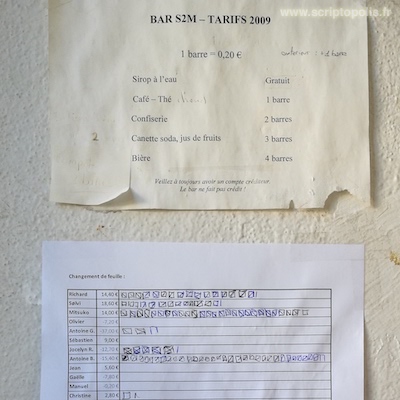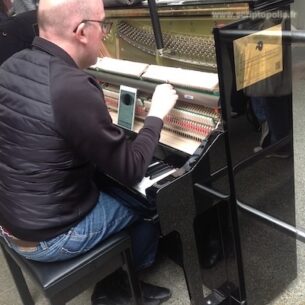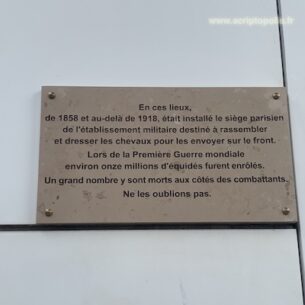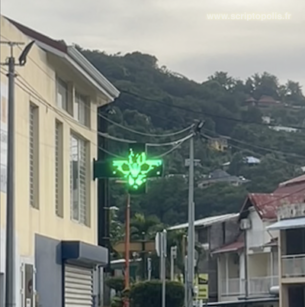Candy bars

By our guest : Victoria Brun
Marseille, 3 December 2021.
The laboratory’s sociability is concentrated in the break room, around the fridge, the coffee machine and the microwave. It is adjoined by the common library, which is overflowing with rare and often old books that focus on the study of sound. The members of the lab meet to chat in the old armchairs, to share a cigarette, to play a few notes on the piano that can be noticed under the pile of paper prints. Above the sink, I note the trace of an internal economic organization. Indeed, from this building which borders the campus, one only ventures out to the canteen at lunchtime. It is the break room that brings everyone together, around provisions bought not from the laboratory’s funds but from a common fund managed by a veteran. The cost of each product has been estimated and converted into a common currency, the bar, whose exchange rate is €0.20. The unit manager proudly points out “the prices have not changed since 2009”!
Each member of the lab has an account, fed by cash deposits to the manager, and debited at the time of the change of sheet, up to the number of self-recorded bars. There is no fantasy about the patterns and ways of counting: the unit is decreed in bars, and we count in packs of five. Only the direction of the diagonal bar is left to the designer’s imagination. Although it is stated that “the bar does not give credit”, some users are already in debit at the time of the change of leaf: the purchase of provisions at a given moment is allowed by the balance between the accounts that are highly supplied and in debit. It is therefore a common fund, not in the sense of mutualization, but in the sense of centralization of resources, management and the privilege of belonging to the group. Not belonging to the laboratory entails an additional cost of one bar per product, whereas belonging to the laboratory means that water syrup is free.
This organization has been preserved from the former laboratory of the unit’s founders: this split, which occurred in 2016, was accompanied by the recovery of the premises, including the experimental equipment and this sheet, torn at its edges, bearing erased traces of pencil, but still there, setting prices. The laboratory, which builds its identity on a minority and interdisciplinary approach to sound, bases its collective on these inherited devices, making the most of the members’ presence in the laboratory around the manips and candies. Of course, it is perhaps first and foremost a question of avoiding going through a vending machine managed by a service provider, moreover by transiting through an objectified common currency that reduces the economic perception of the device. But it is also a play and a way to make the collective exist. The enthusiasm of the researchers who explain to me how it works and the comparison – with derision – of their approach with a propaganda poster taped up next to it, also warped by the weight of the years, fixing the “food value of 1L of wine” in the equivalent of milk, bread, meat and eggs, do not mislead. And the generic headings on the price sheet say nothing about the existence of any debate about the brand of fruit juice, the additives in soda or, worse, the color of Balisto (I’ve only seen purple ones). So, the fact that the price sheet still shows the “S2M” team, which no longer exists administratively, is not an issue, because the same members founded and run the laboratory today.
I don’t dare asking who will support the two bars of my coffee.






